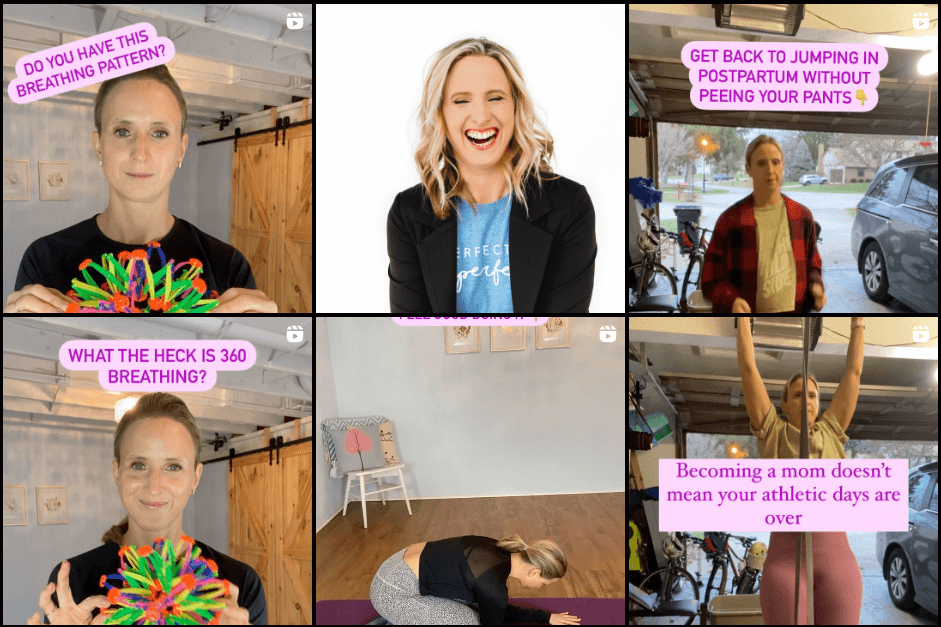My guess is that you’ve probably heard of Diastasis Recti before, but the information online is sometimes not the most accurate. There’s a lot of misinformation and fearful messaging going around and I want you to know the real facts!
In this post, I’ll share exactly what diastasis recti is, how you can minimize the severity of it during pregnancy, and how to heal a diastasis recti naturally in postpartum using a whole-body approach.

What is Diastasis Recti?
You might have heard the terms Diastasis Recti, DR, DRA, or ab separation before…they all mean the same thing: a gap between the right and left rectus abdominis muscle sheets (6 pack muscles).
As your belly grows during pregnancy, the connective tissue at the midline of your abdomen that connects the 2 rectus abdominis muscle sheets (the linea alba) gets thinned and stretched out to make room for your growing baby.
This process is completely normal and not something we should fear! Women’s bodies are truly amazing?!
Diastasis Recti is a NORMAL part of pregnancy as close to 99% of women who carry full term will have some amount of separation by the end of their pregnancy.
It’s important to get educated on the topic of Diastasis Recti to reduce unnecessary fear and movement restrictions.
The main goal during pregnnacy should be to know HOW and WHEN to modify exercises to support your changing body.
You can minimize the severity of a diastasis recti during pregnancy by:
- Learning your own postural tendencies and working on stacking your body (ribs over pelvis) during exercise.
- Learning how to manage intra-abdominal pressure better.
- Modifying movements that puts excessive pressure on your abdomen (unless you’re able to control that pressure with different strategies!).
Your deep core system is a pressure system. If you are not managing the pressure inside your abdomen well, you could be putting excessive pressure on an already weakened abdominal wall. Managing intra-abdominal pressure also requires your rib cage to move well in all direction and your pelvic floor to be able to engage and support you through movements.
If you are constantly thrusting your ribs up towards the sky, your linea alba will get pulled on at all times possibly making it more vulnerable to injury
If you’re pelvis is excessively dumped forward (anterior pelvic tilt), your abdominal wall will get even more lengthened (already stretched from a growing belly) which will also make the connective tissue at the midline more suspectable to trauma.
I like to teach expecting moms how to stack their bodies using strength exercises to help them manage intra-abdominal pressure better.
The Deep Core Connection Breath that I teach in all my programs is also a great way to manage pressure during exercise. A good rule of thumb is to exhale on the exertion of an exercise to support your body during the most demanding part of the exercise.
“Exhaling from the bottom up” is a great cue to use with exercise. As you breathe out, your pelvic floor should slightly lift and engage and then your deep abs should kick in (think of an up arrow).
If you are managing intra-abdominal pressure well, you will minimize the coning (that funky looking bulge) that you might see at the midline of your abdomen.

While not all coning is created equal and we shouldn’t freak out if we see coning once in a while, it’s a good idea to work on trying to reduce it whenever possible.
A soft-to-the-touch coning isn’t as concerning as hard-to-the-touch coning. If the coning is hard, it may be that you are at the end range of the tissue and damage is more likely to occur.
Again, if you see and feel hard coning with every single rep of an exercise, it’s probably time to modify the exercise.
Some movements might become more challenging as pregnancy progresses.
A plank on the ground for example might become too much in the second or third trimester. Bringing the plank to an incline by putting your hands on a bench can reduce the load being placed on the abdomen.
In summary, if you see coning at the midline of your abdomen, try to exhale on exertion, play with your body alignment, decrease the load, or modify the exercise to reduce the load being place on the abdomen.
How to Start Your Healing In Postpartum
All the things that I mentioned above that help reduce your risk of Diastasis Recti during pregnancy also apply to the postpartum period.
It is normal to have some amount of separation in the early weeks postpartum. This study found that 60% of postpartum mom had some amount of Diastasis Recti at 6 weeks postpartum.
What I recommend you work on in postpartum to heal Diastasis Recti naturally.
Work on breathing, rib cage mobility, and core rehab exercises as soon as you feel up for it.
For some, that will be at 2-3 weeks postpartum while others might feel more up to it around 5-6 weeks.
The depth of a diastasis recti and the integrity of the tissue is more important than how many fingers wide it is.
Diastasis Recti healing needs a WHOLE body approach
Here’s the truth: postpartum moms are often NOT challenged enough with their core and pelvic floor rehab after birth.
There is a gap between the rehab world and getting back to [insert sports, CrossFit, running, demanding mom life etc.] while considering core and pelvic health.
Women are underserved in this area.
While I find incredible value in Pelvic Floor Therapy, I strongly believe that the continuation and progression of Pelvic Floor Therapy should be a SMART, PROGRESSIVE, and well thought-out strength training plan.
Postpartum moms are NOT fragile.
They just need guidance to progressively strengthen their body and use appropriate exercise selection to load their tissues safely and create adaptation over time.
The body is all connected and only looking at the abs while trying to heal Diastasis Recti is doing women a disservice.
In short, you need more than “deep core exercises” to heal and strengthen your core after birth.
Deep core exercises are all the rage on social media right now because people like to believe a specific exercise will give them “x” results.
It’s also easy marketing to use words like “deep core exercises” because it makes people believe they are a must.
The reality is that healing Diastasis Recti requires whole body strengthening, including your WHOLE abdominal wall, not just your deep abs.
Some other truths about Diastasis Recti:
- Your alignment affects your abdominal wall
Being constantly stuck in an anterior pelvic tilt for example will lengthen the abdominal wall and make it more susceptible to injury. Making sure you can access a stacked body position is really important! - The dynamics of your rib cage (how well it moves) and your breathing tendencies/strategies influence how well you can recruit your ab muscles. It’s really hard to strengthen your deep abs if you are stuck in a state of inhalation and have a hard time fully exhaling.
Also, only focusing on strengthening the deep core can lead to over tensioning the abs which then can turn into pressure management issues like leaking urine.
While deep core exercises can be helpful in early postpartum to reconnect with the pelvic floor and deep abdominals and rehab the body, I find that a lot of people over tension and end up creating more issues down the road.
Over tensioning is one the the most frequent problems I see with postpartum moms who have done DIY online programs for the deep core.
It’s important to understand that our abs and pelvic floor also need LENGTH.
If you are constantly over tensioning and never letting go, you will run into problems.
My TOP pieces of advice when it comes down to healing Diastasis Recti after birth:
- Keep CHALLENGING your whole abdominal wall + progressing your exercises over time. You want to challenge your tissues enough to make changes but not too much to take a step back. This can be tricky and working with a qualified coach can be helpful.
- Strengthen your body intentionally. A smart & intentional strength training plan is a must!
- Work in all planes of motion (yes, including rotational exercises!). Gone are the days of “do’s and don’ts for Diastasis Recti. Strengthen in all the ways. You won’t know your own body’s limit until you try it.
Learn to get your rib cage moving dynamically and master a good 360 breath.
Learning to stack the body & load is also key!
Hope these tips are helpful in your healing journey.
If you would like a personalized assessment of your posture with tips and exercises tailored to your goals and needs, I offer an Online 80-min Consultation + Assessment Session or check out my 1:1 Online Programming + Coaching services here.



